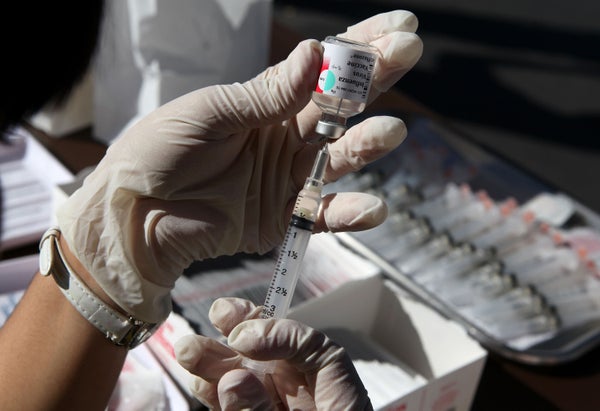The quest for a universal flu vaccine, one that provides long-lasting protection from multiple types of influenza, even those that might cause a pandemic, has moved a step closer.
For the first time, scientists have shown that targeting a specific portion of the flu virus that varies relatively little from strain to strain offers protection in humans. The study was published in the June 3 issue of Nature Medicine.
“If you have a universal flu vaccine you would take off the table the need to have to vaccinate persons every single year, and change the vaccine every year,” says Anthony Fauci, director of the National Institute of Allergy and Infectious Diseases (NIAID). Each year in the U.S., seasonal influenza, or flu, kills more than 36,000 people and hospitalizes 200,000 more. Worldwide, influenza causes 650,000 deaths annually.
On supporting science journalism
If you're enjoying this article, consider supporting our award-winning journalism by subscribing. By purchasing a subscription you are helping to ensure the future of impactful stories about the discoveries and ideas shaping our world today.
Your yearly flu vaccine targets hemagglutinin, one of the two types of proteins that cover the influenza virus. The protein resembles a mushroom, made up of a cap (head) and a stem (stalk).
Current flu vaccines induce the production of antibodies that recognize the hemagglutinin head and inhibit its ability to mediate viral entry into a cell. However, this portion of the protein undergoes rapid mutation to escape the antibodies, making it necessary to develop a new flu vaccine every year.
In contrast, the hemagglutinin stalk is far more resistant to mutations, providing a target for antibodies that block its activity—the reason it may be a candidate for a universal flu vaccine. Several studies have shown that antibodies against the hemagglutinin stem confer protection in animals, but their role in human infections were unknown until now. “We have shown that stalk antibodies correlate with protection in humans,” says Aubree Gordon, a professor of epidemiology at University of Michigan’s School of Public Health and co-author of the study. “We've seen an association between having higher levels of stalk antibodies and being protected from both influenza infection and disease.”
Gordon and her team have been tracking household flu transmission in a cohort in Managua, Nicaragua since 2007. For this specific research, they focused on the 2013 and 2015 flu seasons. “We wanted to do two seasons to make sure that whatever we were seeing wasn't specific to one season,” she says.
In collaboration with the local health center, the scientists were alerted when someone tested positive for influenza. They took that case and enrolled in the study the afflicted individual’s entire household, getting blood samples and following them for three to five weeks. The study tracked a total of 300 household members who lived with the 88 individuals with confirmed influenza. “You're basically getting a population of people who are going to naturally be exposed to influenza,” Gordon explains, “and you see who gets sick, and then you can compare the antibody levels of those who got the flu and those who didn't get the flu to see if specific antibodies or antibody groups are correlating with protection.”
To measure those antibodies, the blood samples were sent to the lab of Florian Krammer, a study co-author who is a professor in the department of microbiology at the Icahn School of Medicine at Mount Sinai in New York. Krammer used a novel assay to measure the hemagglutinin stalk antibodies. It was built from a molecule containing the stalk of the H1N1 virus—the influenza strain that was the subject of this research—and the head of an avian influenza virus (H6N1) that is not present in humans.
“This construct allows us to measure antibodies for the stalk only,” Krammer explains, adding: “We developed it here, and we have used it for the last two or three years to measure immune response in animals.” However, they didn’t have a study that could allow them to test it in humans. “It was with Aubree Gordon's cohorts in Nicaragua that this was possible,” he says. The tests showed that a rise of four times in the stalk antibody levels correlated with a 42 percent reduction in influenza infection, and about a 50 percent reduction in symptomatic influenza.
The study, Fauci says, “provides a proof of concept that if we can induce [hemagglutinin] stem antibodies we may be able to have what we call an important step toward a universal flu vaccine. The people pursuing this line of research will be much more energized about doing it.”
Work has already begun on vaccine development. At NIAID’s Vaccine Research Center, Barney Graham and his team have already started an early-stage (phase I) trial of a vaccine that aims to induce hemagglutinin stem antibodies. “His approach is to take the stem part of the hemagglutinin and put it onto a nanoparticle that induces a very good immune response,” Fauci says, adding: “Peter Palese at the Icahn School of Medicine at Mount Sinai is looking at what happens when you shave off the head of the hemagglutinin molecule and only present the stalk to the body, can you get good antibodies? Those are two laboratories that are looking at the approach of selectively making antibodies against the stalk.”
Krammer points out a few caveats for the Nicaraguan study. Influenza A viruses can be categorized into two phylogenetic groups (group 1 and group 2). H1N1, the virus that was studied, belongs to group 1. The research, already underway in Nicaragua, must now be replicated with group 2 viruses to determine if hemagglutinin stalk antibodies also offer protection.
Also, what was measured in the initial study provided protection induced by natural infection. “We don’t know if induced antibodies through vaccination are as good. We need to look into that,” he says. The next few years should reveal whether this promising finding will turn into a genuine prospect for a long-sought universal flu vaccine.
